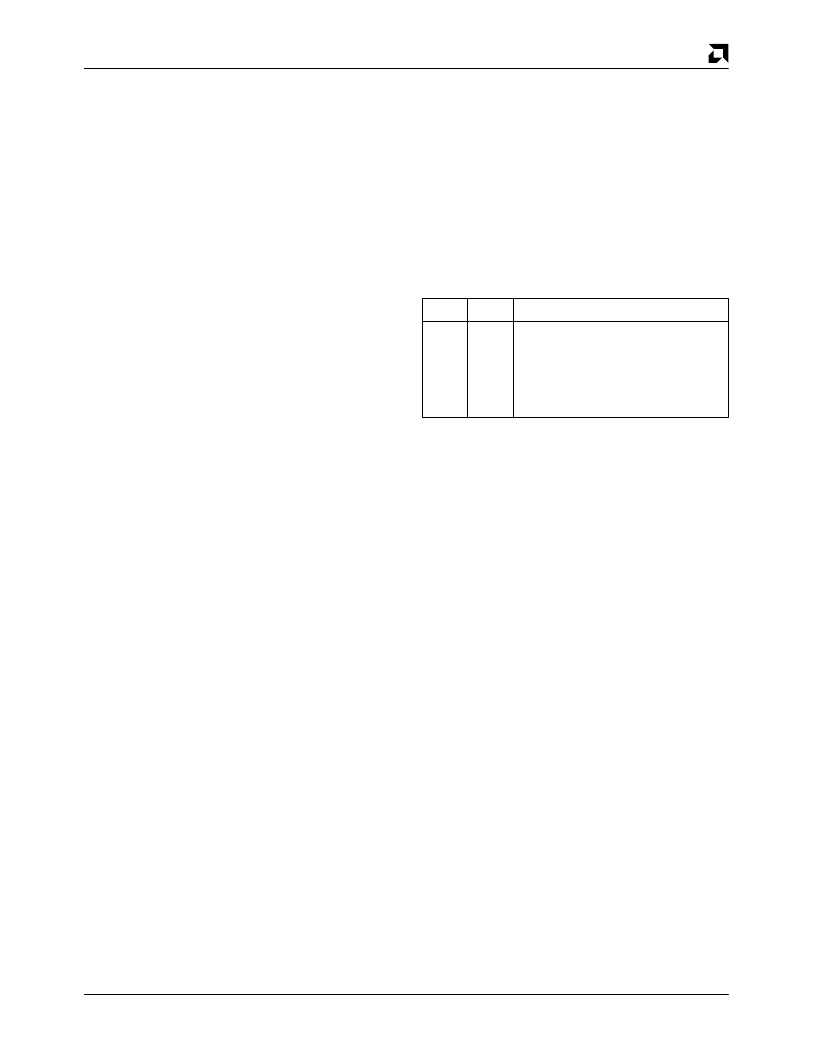- 您現(xiàn)在的位置:買賣IC網(wǎng) > PDF目錄366544 > AM53CF94JC (ADVANCED MICRO DEVICES INC) Enhanced SCSI-2 Controller (ESC) PDF資料下載
參數(shù)資料
| 型號: | AM53CF94JC |
| 廠商: | ADVANCED MICRO DEVICES INC |
| 元件分類: | 總線控制器 |
| 英文描述: | Enhanced SCSI-2 Controller (ESC) |
| 中文描述: | SCSI BUS CONTROLLER, PQCC84 |
| 封裝: | PLASTIC, LCC-84 |
| 文件頁數(shù): | 13/76頁 |
| 文件大?。?/td> | 735K |
| 代理商: | AM53CF94JC |
第1頁第2頁第3頁第4頁第5頁第6頁第7頁第8頁第9頁第10頁第11頁第12頁當前第13頁第14頁第15頁第16頁第17頁第18頁第19頁第20頁第21頁第22頁第23頁第24頁第25頁第26頁第27頁第28頁第29頁第30頁第31頁第32頁第33頁第34頁第35頁第36頁第37頁第38頁第39頁第40頁第41頁第42頁第43頁第44頁第45頁第46頁第47頁第48頁第49頁第50頁第51頁第52頁第53頁第54頁第55頁第56頁第57頁第58頁第59頁第60頁第61頁第62頁第63頁第64頁第65頁第66頁第67頁第68頁第69頁第70頁第71頁第72頁第73頁第74頁第75頁第76頁

P R E L I M I N A R Y
AMD
13
Am53CF94/Am53CF96
PIN DESCRIPTION
Host Interface Signals
DMA 15–0
Data/DMA Bus
(Input/Output, Active High, Internal Pull-up)
The configuration of this bus depends on the Bus Mode
1–0 (BUSMD 1–0) inputs. When the device is config-
ured for single bus operation, the host can access the
internal register set on the lower eight lines while DMA
accesses can be made to the FIFO using the entire bus.
When using the Byte Mode via the BHE and A0 inputs
the data can be transferred on either the upper or lower
half of the DMA 15–0 bus.
DMAP 1–0
Data/DMA Parity Bus
(Input/Output, Active High, Internal Pull-up)
These lines are odd parity for the DMA 15–0 bus. DMAP
1 is the parity for the upper half of the bus (DMA 15–8)
and DMAP 0 is the parity for the lower half of the bus
(DMA 7–0).
ALE [A3]
Address Latch Enable [Address 3]
(Input, Active High)
This is a dual function input. When the device is config-
ured for the dual bus mode (two buses, multiplexed and
byte control), this input acts as ALE. As ALE, this input
latches the address on the AD 7–0 bus on its low going
edge. When the device is configured for all other bus
modes, this input acts as A3. As A3, this input is the third
bit of the address bus.
DMARD
[A2]
DMA Read [Address 2]
(Input, Active Low [Active High])
This is a dual function input. When the device is config-
ured for the dual bus mode (two buses, multiplexed and
byte control), this input acts as
DMARD
. As
DMARD
,
this input is the read signal for the DMA 15–0 bus. When
the device is configured for all other bus modes, this in-
put acts as A2. As A2, this input is the second bit of the
address bus.
BHE [A1]
Bus High Enable [Address 1]
(Input, Active High)
This is a dual function input. When the device is config-
ured for the dual bus mode (two buses, multiplexed and
byte control), this input acts as BHE. As BHE, this input
works in conjunction with AS0 to indicate the lines on
which data transfer will take place. When the device is
configured for all other bus modes this input acts as A1.
As A1, this input is the first bit of the address bus.
AS0 [A0]
Address Status [Address 0]
(Input, Active High)
This is a dual function input. When the device is config-
ured for the dual bus mode (two buses, multiplexed and
byte control), this input acts as AS0. As AS0, this input
works in conjunction with BHE to indicate the lines on
which data transfer will take place. When the device is
configured for all other bus modes, this input acts as A0.
As A0, this input is the zeroth bit of the address bus.
The following is the decoding for the BHE and AS0
inputs:
BHE
AS0
Bus Used
1
1
Upper Bus – DMA 15–8, DMAP 1
1
0
Full Bus – DMA 15–0, DMAP 1–0
0
1
Reserved
0
0
Lower Bus – DMA 7–0, DMAP 0
DREQ
DMA Request
(Output, Active High, Hi-Z)
This output signal to the DMA controller will be active
during DMA read and write cycles. During a DMA read
cycle it will be active as long as there is a word (or a byte
in the byte mode) in the FIFO to be transferred to mem-
ory. During a DMA write cycle it will be active as long as
there is an empty space for a word (or a byte in mode 2)
in the FIFO.
DACK
DMA Acknowledge
(Input, Active Low)
This input signal from the DMA controller will be active
during DMA read and write cycles. The
DACK
signal is
used to access the DMA FIFO only and should never be
active simultaneously with the
CS
signal, which ac-
cesses the registers only.
AD 7–0
Host Address Data Bus
(Input/Output, Active High, Internal Pull-up)
This bus is used only in the dual bus mode. This bus al-
lows the host processor to access the device’s internal
registers while the DMA bus is transferring data. When
using multiplexed bus, these lines can be used for ad-
dress and data. When using non multiplexed bus these
lines can be used for the data only.
相關PDF資料 |
PDF描述 |
|---|---|
| Am53CF94JCW | Enhanced SCSI-2 Controller (ESC) |
| Am53CF94KC | Enhanced SCSI-2 Controller (ESC) |
| Am53CF94KCW | Enhanced SCSI-2 Controller (ESC) |
| Am53CF96 | Enhanced SCSI-2 Controller (ESC) |
| Am53CF96JC | Enhanced SCSI-2 Controller (ESC) |
相關代理商/技術參數(shù) |
參數(shù)描述 |
|---|---|
| AM53CF94JCW | 制造商:AMD 制造商全稱:Advanced Micro Devices 功能描述:Enhanced SCSI-2 Controller (ESC) |
| AM53CF94KC | 制造商:AMD 制造商全稱:Advanced Micro Devices 功能描述:Enhanced SCSI-2 Controller (ESC) |
| AM53CF94KCW | 制造商:AMD 制造商全稱:Advanced Micro Devices 功能描述:Enhanced SCSI-2 Controller (ESC) |
| AM53CF96 | 制造商:AMD 制造商全稱:Advanced Micro Devices 功能描述:Enhanced SCSI-2 Controller (ESC) |
| AM53CF96JC | 制造商:AMD 制造商全稱:Advanced Micro Devices 功能描述:Enhanced SCSI-2 Controller (ESC) |
發(fā)布緊急采購,3分鐘左右您將得到回復。